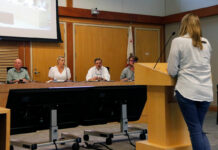Our California drought is a tangle of mathematics problems. And, so far, it doesn’t look like the numbers are adding up. Facing our worst drought in 120 years, we know the severe lack of rain will require a lot of subtraction and sacrifice. This math test is no longer optional. Last week, Gov. Brown made it mandatory and we all have to save a minimum of 25 percent over previous rates of water usage.
So what does a 25 percent water use restriction look like? We’ve been told it will mean brown lawns and dirty cars. Shorter showers, fewer flushes and fixing leaky faucets we can handle. But are we ready for real changes of lifestyles and habits? We may be forced to track our water bills the same way we’ve been watching the pricing spikes at the gasoline pump. Instead of carpooling, there may be no swimming pooling.
We are now four years into this drought with no end in sight. The rest of this year — especially during a hot summer — will offer a stern math lesson that not enough rain and too many thirsty spigots will add up to dry, dusty and cranky numbers.
In fact, there is a long list of numbers that define our drought. Here are some of them:
One — California is now home to 38 million people who have been depleting the state’s vast reservoir and surface water supplies since 2002, well before the drought period. Only one year of water supply remains. We have been pumping groundwater reserves for the last decade to feed Central Valley agriculture and the deserts of southern California. The snowpack in the Sierra Nevada mountains is just five percent of normal. Conditions are only slightly better in our more local coastal region.
214,000 — During Sonoma County’s last severe drought period of 1975-77, the county’s population was 286,000. Today our population is 500,000. Our Russian River watershed didn’t get bigger and our rainfall totals are lower than back then. But the county population increase of 214,000 people means we have to share our drought-depleted water sources with the equivalent of almost eight new Windsors.
110 — Residents of Sonoma County already have reduced their daily water use to just 110 gallons, according to the Sonoma County Water Agency. This total does not include industrial or agricultural use. SCWA officials say 80 percent of this daily personal use is for watering lawns, landscaping and cleaning sidewalks and driveways. Just letting our lawns turn brown could buy us a whole year of drought relief. We live in the Golden State, not the Green State. Golden brown is our natural color.
$1,100-$2,000 — That is the price some California farmers are now paying for an acre foot of water (326,000 gallons) to keep feeding the world’s fifth largest food supplier. Two years ago, the same water cost just $400 an acred foot. Nobody knows where the price of water is headed, but over-demand and low supply will likely mean both much higher food prices and millions of acres of empty fields.
Houses and grapes — Raw numbers don’t tell the true story of our county’s most valuable crop and future demand for urban and domestic water needs. It may be true that winegrapes use less water than most crops, but that doesn’t excuse our local farmers from their own math tests of less irrigation and more conservation. It is also true that new housing means more demand on existing water supplies. But Sonoma County has another math problem and that is a lack of affordable housing. If we mandate water saving and energy efficient appliances and construction for all residences, we can continue to work on a solution to build necessary housing for our workers and children.
Zero — That is the number of years we have left to get serious about adapting our lifestyles to a land and climate that has known multi-year droughts for a long, long time.
— Rollie Atkinson








